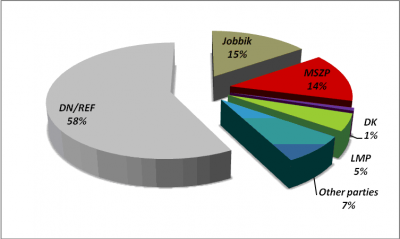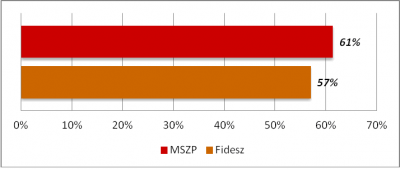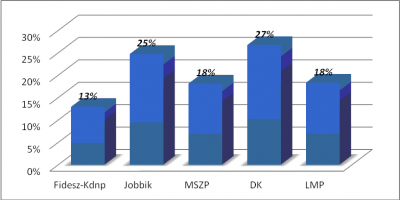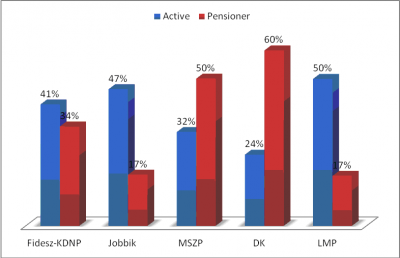The Republikon Institute carried out a comprehensive and in-depth analysis concerning the electoral base of parties in the parliament. Apart from the characterization of voters the analysis examines some special questions in connection with the political parties which reached the required threshold in 2010 parliamentary elections: in case of Fidesz our major focus was on the so called ’disillusioned voters’, we compared the choices of values among MSZP and Fidesz voters, we analysed the radical attitudes of Jobbik’s voters base, and at the same time we tried to map the exact relationship (if there is any) between LMP and a former parliamentary party, SZDSZ, focusing on the presence of liberal attitudes. Since there is no detailed description of the Democratic Coalition’ votes, in their case we tried to fill this gap.
1. figure
Fidesz-leavers current party choices (since 2010)
Study concerning the Fidesz-leavers shows that measures of the Fidesz government in the past two years favoured – therefore kept their support relatively well – mainly a group consisting of high-income, high-status voters. In contrast, the rural, low-skilled, low-income level voters are disappointed in the same measures of the two-third government – therefore it is not surprising at all that the bulk of them left the ruling party, more than half of this group would not give their vote to Fidesz if the elections were held next Sunday. It can be clearly seen that this process is not the matter of 2010 elections bloated voters’ natural weight loss: half of the leavers are ’old’ (voted for the Fidesz in the past two elections in 2006 and in 2010 as well) Fidesz voters. So far opposition parties were hardly able to address the leavers, around 60 percent of them has no clue whom they should vote for: mainly MSZP and Jobbik could gain some votes from the Fidesz-leavers. Predictions on the 2014 elections, however, indicate that Fidesz could not expect that these frustrated voters will return as a mass to their former choice: only one-fourth of the disillusioned voters may sooner or later make a home run.
2. figure
The proportion of maximum
eight primary school graduates of voters between the voters of parties
One third of dissented voters are clearly leaning towards the left-wing parties – and especially the MSZP – they ended up in, or sympathize with them, and about one-sixth of them supported the Jobbik’s camp.
3. figure
Gender ratio among the voters of the parties
The study of the Fidesz and the MSZP voters’ choice of values showed cases in which there is no real difference between the voters opinions on two sides: concerning the strong support of authoritarianism, and specific economic and social matters (wide variety of services expected from the state or opposing support for groups in a fixed situation) – voters of the two parties represent a very similar position. In contrast the generally worded social equality and the direction of economic policy issues showed a significant difference between the two parties voters: the socialist voters, as it was expected, clearly stand up for social equality and also for economic issues they consider to be important regarding creating jobs and increasing social spending. In contrast, the Fidesz voters are more likely to accept the social inequalities, they would cut down on social spending at the cost of tax cuts, and they would not let foreign investments into the country, even if they create jobs.
4. figure
The Gypsies themselves are responsible for their problems,
therefore those ought to be resolved by them – proportion of those agreeing with this statement
Jobbik voters’ study shows that the voters’ radicalism is clearly visible in concrete cases but its presence is less evident in value choices. Fidesz voters think more radical than the voters of Jobbik in topics such as authoritarian education or conformism, we have found the greatest consensus among voters of Jobbik only in the case of supporting leadership. It is worth mentioning that these questions have a strong support among the society – the vast majority of people do support these issues; therefore the real fault line runs between the two party groups: Fidesz-Jobbik-MSZP versus LMP-DK. In specific cases, however, Jobbik voters’ radicalism is clearly displayed – Jobbik voters are one and a half times or twice as much likely to reject foreign capital or the support of the Roma society than any other political parties’ supporters.
5. figure
Religious approach is the most far away from me – percentage of people who agree with the statement
Data analysis shows that neither the party choice nor the value choices of the LMP voters are following the pattern of the former parliamentary party’s (SZDSZ) path. Therefore it is groundless to call them the „new SZDSZ”: only one-tenth of the LMP camp voted for the SZDSZ in 2006. However, the main voter base’s characteristics (young, highly qualified, high-income level groups living in the capital) show a strong similarity to the former SZDSZ camp, and that is also an undeniable fact that most of the former SZDSZ voters (the former Liberal Democrat voters (a quarter of the 2006 camp)) today support LMP. Although the rhetoric of LMP often rejects liberalism, the voters definitely assume that: half of the voters identified themselves as liberal on the liberal-conservative scale; moreover, most of them are best characterized by this identity. The voters’ values analysis also showed that this liberalism concerns only the cultural dimension: LMP voters mostly reject the authoritarian opportunities. In economic issues they are clearly far from liberalism: they represent a definite leftist position in social equity and other economic policy issues. Based on these facts we can say the LMP inherited only some segments from the former SZDSZ-voters: the segments where the voters are culturally liberal, but in economic issues they represent a definite leftist position.
6. figure
Proportion of voters with 250,000 HUF income or more
The electoral base of Democratic Coalition’s is well defined: mainly old, highly-qualified, pensioners from the capital with average salary. The DK-voters are the most determined voters: more than four-fifths of their voters would for sure participate in the elections held next Sunday. DK supporters – as well as the MSZP’s voters base – have a clear and definite self-image but consider themselves to be more liberal than socialist voters do. The DK-voters are not as diverse as it is assumed by the leadership of the party: half of the supporters consider themselves to be socialist or social democrat, while only one-sixth have declared a liberal self-definition, and only 7-8 percent of them claimed to be a conservative or to have national feelings. This is not an accident: DK’s voters base mainly (60 percent) consists of former MSZP voters, DK has not really been able to win new voters for themselves. It also seems clear that the DK-voters have not permanently broken up with the MSZP: if, for some reason the DK would not be able take part in the election, their voters’ clear majority (60 percent) would vote for the MSZP.
7. figure
Proportion of the active and retired party voters










